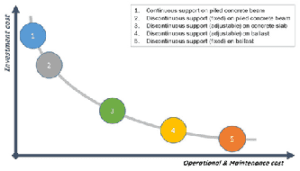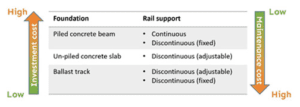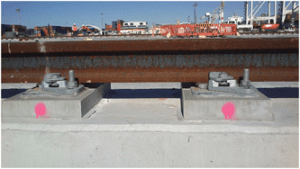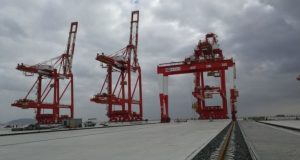
Maarten Impens, Group CEO,
Dubai (UAE)
Whether you are designing a track for manually driven Rail Mounted Gantry Cranes (RMGC) or driverless Automated Stacker Cranes (ASC), the design and installation of the rail track is key to a successful operation of the cranes. Especially with automated cranes, traveling at increasing speeds up to 240 m/min and without a driver keeping an eye on the track, the tolerances on installation of the rail and the supporting foundations are critical to maximize end-to-end efficiency of the cranes and reduce operational downtimes.
When designing the rail track for any rail mounted RMG or ASC, it is important to make an analysis of investment cost versus maintenance cost, not only of the rail system but of the entire civil foundation of the container yard.
A crane track solution to suit your foundation
Over the years, Gantrex has closely followed the developments in the container stacking cranes, the increasing speeds and efficiencies, and the continued pressure on cost effectiveness of the system. Whereas 10 years ago, container terminals were willing to make the investment for a piled foundation and a continuously supported rail track regardless of the ground conditions, today this is no longer the reality in every terminal around the world. Depending on the customer’s budget, Gantrex can propose a variety of designs for the container crane runway to suit the type of crane and the underlying foundation. And for each solution, the goal is to design a rail track that can be operated in the strictest of tolerances (ISO12488-1 Class 1).
For a container terminal to be designed optimally, it is imperative for crane rail specialists such as Gantrex to work closely with the civil engineering consultants prior to construction of the foundation.

The first decision to make is the selection of the foundation (piled foundation, un-piled concrete slab or a ballasted track design), depending on the underlying ground conditions of the container yard. Whilst a ballast track design requires the lowest upfront investment, it does not always provide the optimal cost of ownership once you factor in maintenance requirements (e.g. frequency and cost of ballast tamping) and effects on operational efficiency. On the other side of the spectrum, a piled crane beam provides the most solid foundation with the least settlement (and therefor maintenance) but comes at a much higher investment cost. If a compromise needs to be made on the investment cost, and if the underlying soil condition allows, the rail could be supported by a concrete slab without piling. In this case, the settlement of the underlying soil needs to be calculated and if acceptable, the settlement could be overcome by using an adjustable rail chair to bring the rail back within operational tolerances. This will increase operational maintenance cost, but keep investment cost in check and has been found an acceptable trade-off for some projects in China, Australia and USA where Gantrex supplied the rail system. It is important to employ a certified and renowned engineering company and an experienced crane rail system designer to make that judgement.

Rail System Designs
When designing the rail system there are great number of parameters to take into account, not in the least the design of the cranes themselves. Especially ASC cranes, which operate in the most demanding of dynamic circumstances due to their high speeds and variety of structural designs, provide a challenge when it comes to designing the most suitable rail system. ASC or RMG cranes could have a rigid frame or a structure with pivoting leg, which have an entirely different effect on the horizontal load transfer from the crane through the rail into the foundation. And in case of rigid frame structures, there is a difference between side-loaded cranes with a cantilever design as opposed to end-loaded cranes which are generally more forgiving on the rail system.
Whilst there is no such thing as an off-the-shelf crane rail solution, and every project requires bespoke engineering, the support of the rail track can broadly be categorized into 3 classes: (1) continuous support, (2) fixed discontinuous and (3) adjustable discontinuous. While continuous support typically requires a piled crane beam foundation due to the lack of vertical adjustability, the discontinuous supports have been found on different kind of foundations (piled, un-piled and ballast) depending on the ground condition (i.e. settlement expectation) and requirement for relevelling over the design life of the rail track (typically 20 years). Given that continuous and fixed discontinuous solutions have been in the market for a number of decades, adjustable discontinuous systems deserve a closer look.
Discontinuous Support (Adjustable)
In 2012, Gantrex developed an adjustable chair solution which meanwhile has been implemented successfully in container terminals in Australia, USA, China and across Europe.
The main challenge in the design of the system was to allow relevelling of the system at any given time during the 20 year design life of the rail track, by use of galvanized shims, without having to untighten the anchor bolts. Since anchor bolts are typically cast in the foundation, either directly in the concrete, using a cement grout, or some kind of anchoring adhesive, they are by definition “anchored in” and therefore nearly impossible to replace. Instead, Gantrex was challenged to design a system where anchor bolts, once torqued, would remain untouched during the design life of the system. And so Gantrex developed its patented adjustable chair with a 3-bolt design, where the 3 functions of the bolts — clip assembly, plate assembly and anchoring — have been properly separated.

The second challenge was to answer to the requirement for 100mm of vertical adjustment whilst keeping the maximum stability of the rail fastening system under extreme horizontal loads. Indeed, the more the system was being relevelled, and the higher the shimmed solution became, the more critical became the stability of the “tower” in resisting horizontal forces. Once again, by seperating the clip bolts and the plate assembly bolts using a 3-bolt design, in combination with the patented RailLok® clip system, Gantrex’ system has been able to resist in the most strenuous of circumstances.
For more information on how to optimize the cost effectiveness of the crane rail system without compromising on the reliability and the stability of the rail track, contact: www.gantrex.com






